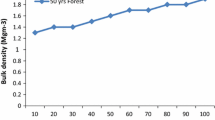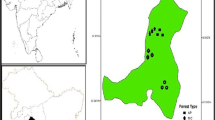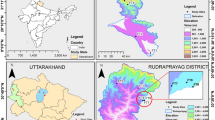Abstract
Recovering logged-over forest ecosystem increases CO2 efflux into the atmospheric carbon pool in response of environmental factors to change in soil temperature and moisture. These CO2 outbursts can have a marked influence on the ecosystem carbon balance and thereby affect the atmospheric carbon pool. The study was conducted in a 10 years logged-over forest of Sungai Menyala forest, Port Dickson, Negeri Sembilan, Malaysia. The measurements of soil CO2 effluxes were conducted using a continuous open flow chambers technique connected to a multi gas-handling unit and infrared CO2/H2O gas analyser. The aim of this study is to determine the percentage of CO2 contributed into the atmosphere from a recovering 10 year logged-over lowland forest. One-way analysis of variance (ANOVA) was used to test the significance correlation between soil CO2 efflux and environmental variables. Post-hoc comparisons were made using Tukey test (p < 0.05), and multiple linear regressions were used to determine the impact of environmental factors on soil CO2 efflux. Soil CO2 efflux range from 345.6 to 600.4 mg/m−2/h−1 with the highest efflux in the afternoon attributed to increase in soil temperature and moisture. Higher soil temperature and moisture recorded signify the influential factor. Furthermore, the predictor environmental variables; Soil Organic Carbon (SOC), Total Organic Carbon (TOC), Soil Moisture Content (SMC), Bulk Density, Below Ground Carbon Stock, Total Aboveground Carbon Biomass (TAGB), soil pH, Nitrogen to Carbon ratio account for the spatial and temporal variation in soil CO2 efflux. These factors attributed to increase in CO2 efflux into the atmosphere.
Access provided by Autonomous University of Puebla. Download conference paper PDF
Similar content being viewed by others
Keywords
Highlights
-
Age of trees and canopy density are key factors for carbon input.
-
Soil properties and carbon stock are the determinants factors for soil CO2 efflux.
-
The tropical rainforest deforestation increases soil temperature and moisture.
-
High rate of soil CO2 efflux increases forest and atmospheric carbon pool.
Introduction
Increase in the greenhouse gas from oceanic, terrestrial and atmosphere carbon pool has been considered as a major contributor to global warming as well as climatic change (Conant et al. 2011). However, recovering forest of the terrestrial ecosystems are consider among the deforested areas to emit high efflux of soil carbon dioxide (CO2) to the atmosphere (Brito et al. 2013). Soil CO2 has been estimated to comprise of about 50–80 % of the terrestrial ecosystem respiration (Davidson et al. 2000a; Giardina and Ryan 2002), with a total of 60–80 Pg carbon annual (Raich and Potter 1995).
Recovering forest resulted from deforestation are found to have great implication on the atmospheric carbon pool, by contributing much percentage of CO2 compared to undisturbed forest ecosystem (Ewel et al. 1981; Toland and Zak 1994). This action will resulted to unexpected change in physiological activity, microbial activity, litter fall input and root density, thereby increases efflux of soil CO2 into the atmosphere as result of change in temperature and decay of fine roots (Hanson et al. 2000). In spite many researches on CO2 efflux, little has been documented on the impact of recovering Dipterocarpus lowland tropical forest of peninsular Malaysia. This study will examine the rate and percentage of soil CO2 efflux in the recovering 10 years forest and its contribution to the atmospheric carbon pool.
Materials and Methods
Site Description
Field experiment was conducted over a period of 6 months, January to June 2013, in the 10-year recovering logged-over Dipterocarp forest of Sungai Menyala, Port Dickson, Negeri Sembilan, Malaysia. The reserve forest is an extension forest for Seremban forest reserve. The study area is approximately 55 km from Kuala Lumpur. The reserve forest experiences equatorial climatic conditions with a temperature of 23.7 °C and relative humidity of 59–96 %, with an average of 83 %. Three experimental plot of 50 × 50 m, 70 × 70 m and 100 × 100 m with replicate were designed.
Soil CO2 Efflux and Environmental Variables Measurement
Soil CO2 efflux was measured each day from 0800 to 1700 h for 6 month, using two continuous open flow chambers connected to a multi gas-handler, which provides a channel to regulate the flow of CO2 from various chambers to a flow meter connected to a CO2/H2O gas analyser. Soil temperature, soil moisture and soil water potential were measured at a depth of 5 cm at intervals of 5 min concurrently with each soil CO2 chambers.
Litter trap net was placed 1 m above the forest floor of ten each in a plot for the collection of leaves at 14 days interval to ascertain Carbon to Nitrogen ratio. Total aboveground biomass and leaves area index (LAI) were determined both measuring a total 630 trees in each plot. Soil samples were taken randomly at three sampling points of each plot from a depth of 0–100 cm. Standard method was used to analysed for SOC, SMC, bulk density and pH while Walkley–Black method was used to determine TOC (Sollins et al. 1999), and below ground carbon stock was based on Eleanor 2008 method. To establish the attribution of the environmental variables to soil CO2 efflux, and recovering 10 years forest, a statistical correlation and multiple linear regression models was employed. Also principal component analysis (PCA) was used to reduce large dataset (Yongming et al. 2006).
Results and Discussion
Based on the hourly and daily soil temperature and moisture changes, it was observed that soil CO2 efflux significantly varies. Efflux ranged between 345.6 to 600.4 mg/m−2/h−1 across the 10 years logged-over Dipterocarp forest from 0800 to 1700 h with the low efflux occurring in the morning hours of 0800 to 1100 h and an instantaneous high efflux rates at 1300–1500 h. Higher values were recorded in the month of January to March and lower efflux was experienced between April to June. The corresponding values for soil temperature, moisture and water potential in 5 cm soil depth fluctuate across the months from 23 to 25 °C, 18–38 % and 96.6–97.6 %, respectively. Soil bulk density increased with depth with a corresponding high value of top 10 cm soil containing TOC and SOC of 1.9 % and 5.55 %, respectively. Soil moisture content occurred at 20.0 with a corrective factor 1.2. The soil pH of the study area was slightly acidic in nature (5.55). In addition, carbon and nitrogen input from litter fall contributed about 42.92 % and 1.16 %, respectively with soil total carbon in top 100 cm was 75.2 Mg C/m2.
The total amount of soil CO2 contributed in the logged forest to the atmospheric carbon pool was calculated based on the flow rate and soil area sampled. The result indicated lower soil CO2 efflux of 345.6 mg/m−2/h−1 in the morning, with the highest peak of 600.4 mg/m−2/h−1 in the afternoon and with an efflux declining in the evening. This coincided with the daily soil temperatures variation across the day. However, there were significant differences in total daily efflux between the early months and mid months of the year.
The multiple linear regression models indicated a strong correlation between soil CO2 and environmental variables (r = 0.85, p < 0.001), explaining the impact of soil temperature and moisture on soil CO2 efflux and the overall CO2 efflux into the atmosphere due to deforestation. Results also indicated soil CO2 efflux rate was in respond to the increase in TOC, SOC, soil moisture content and the acidic. Bulk density increases with depth, indicating the role of pore spaces played in water movement, capacity exchange catio, electric conductivity and microbial activity. The carbon to nitrogen ratio was attributed to canopy stand density based on the age of the forest, serving as a nitrate for microbial activities (lignin and cellulose). This explains the variation in soil respiration of different forest age stand. Therefore, the environmental factors were found to have much significantly relationship with soil CO2 efflux across the 10 year logged-over Dipterocarp lowland forest.
Conclusion
The total amount of soil CO2 efflux from the 10 years logged-over forest as was computed in the derived equation, showed that the recovering forest ecosystem displayed high rate of CO2 efflux of 600.4 mg/m−2/h−1. This shows that the interaction among the environmental factor influences soil CO2 efflux, therefore resulting to high percentage of soil CO2 efflux from the 10 year logged-over Dipterocarp forest into the atmosphere. This situation is created as a result of deforestation as the forest is recovering, having less canopy stand density to capture CO2 for photosynthesis and also to serve as a carbon sink. Therefore the negative impact resulted from this scenario, is the increase in CO2 efflux into the atmospheric carbon pool. This result will also help to determine the rate and the percentage of soil CO2 efflux into the atmospheric carbon pool due to deforestation in Peninsular Malaysia.
References
Brito P, Trujillo JL, Morales D, Soledad M, Wieser G (2013) Acta Oecologica Soil moisture overshadows temperature control over soil CO2 efflux in a Pinus canariensis forest at treeline in Tenerife, Canary Islands. Acta Oecologica 48:1–6
Conant R, Ogle S, Paul E, Paustian K (2011) Measuring and monitoring soil organic carbon stocks in agricultural lands for climate mitigation. Front Ecol Environ 9:169–173
Davidson EA, Savage K, Bolstad P, Clark DA, Curtis PS, Ellsworth DS, Hanson PJ, Law BE, Luo Y, Pregitzer KS, Randolph JC, Zak D (2000a) Below ground carbon allocation in forests estimated from litterfall and IRGA-based soil respiration measurements. Agric For Meteorol 113:39–51
Ewel J, Berish C, Brown B, Price N, Raich J (1981) Slash and burn impacts on a Costa Rican wet forest site. Ecology 62(3):816–829
Giardina CP, Ryan MG (2002) Total belowground carbon allocation in a fast-growing eucalyptus plantation estimated using a carbon balance approach. Ecosystems 5:487–499
Hanson PJ, Edwards NT, Garten CT, Andrews JA (2000) Separating root and soil microbial contributions to soil respiration: a review of methods and observations. Biogeochemistry 48:115–146
Raich JW, Potter CS (1995) Global patterns of carbon dioxide emissions from soils. Global Biogeochem Cycles 9:23–36
Sollins P, Glassman C, Paul EA, Swanston C, Lajtha K, Heil JW, Elliott ET, Robertson PG (1999) Soil carbon and nitrogen: pools and fractions. Standard soil methods for long-term ecological research. Oxford University Press UK 89–105
Toland DE, Zak DR (1994) Seasonal patterns of soil respiration in intact and clear-cut northern hardwood forests. Can J For Res 24:1711–1716
Yongming H, Peixuan D, Junji C, Posmentier ES (2006) Multivariate analysis of heavy metal contamination in urban dusts of Xian, central China. Sci Total Environ 355(1–3):176–186
Acknowledgments
This study was carried out with the support of Research Universiti Grant Scheme, (RUGS VOT NO. 9364800, Project No. 0302122070), provided by Universiti Putra Malaysia. We also acknowledge the contribution of the Forest Department of Negeri Sembilan Malaysia, the forest rangers of Sungai Menyala Forest and the staff of Faculty of Environmental Studies, Universiti Putra Malaysia for their valuable assistances.
Author information
Authors and Affiliations
Corresponding author
Editor information
Editors and Affiliations
Rights and permissions
Copyright information
© 2014 Springer Science+Business Media Singapore
About this paper
Cite this paper
Hosea, M.K., Abdullah, A.M., Aris, A.Z., Nuruddin, A.A. (2014). Soil Carbon Dioxide Efflux and Atmospheric Impact in a 10 Years Dipterocarpus Recovering Lowland Tropical Forest, Peninsular Malaysia. In: Aris, A., Tengku Ismail, T., Harun, R., Abdullah, A., Ishak, M. (eds) From Sources to Solution. Springer, Singapore. https://doi.org/10.1007/978-981-4560-70-2_31
Download citation
DOI: https://doi.org/10.1007/978-981-4560-70-2_31
Published:
Publisher Name: Springer, Singapore
Print ISBN: 978-981-4560-69-6
Online ISBN: 978-981-4560-70-2
eBook Packages: Earth and Environmental ScienceEarth and Environmental Science (R0)




